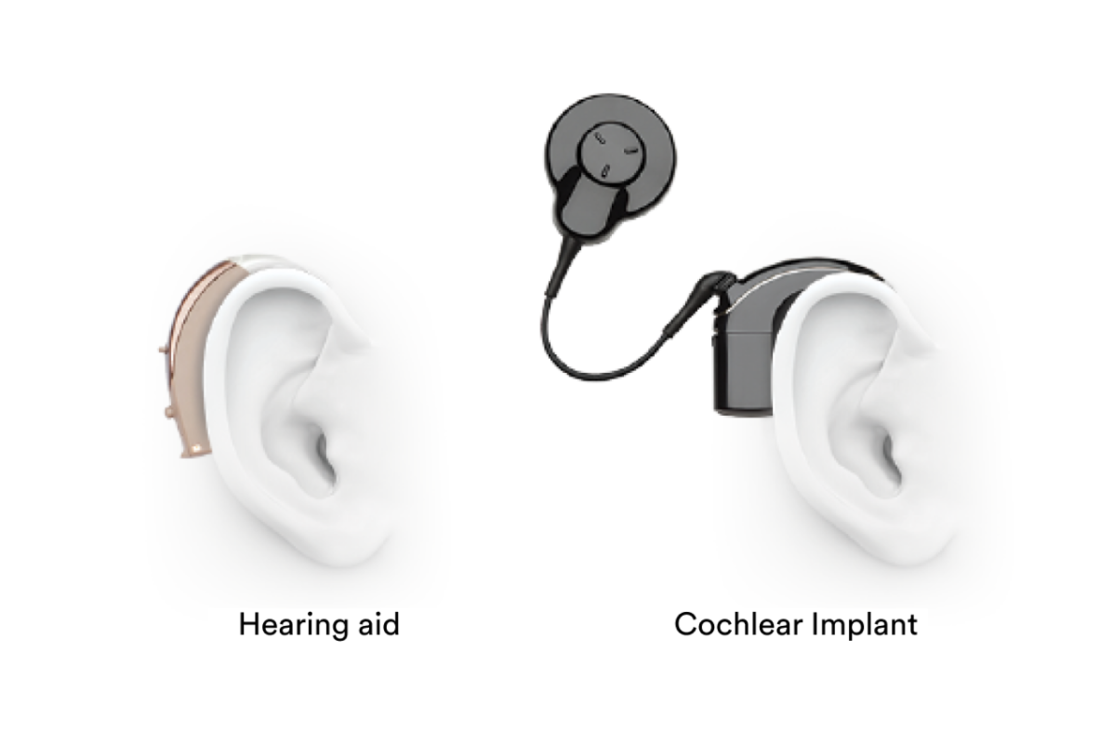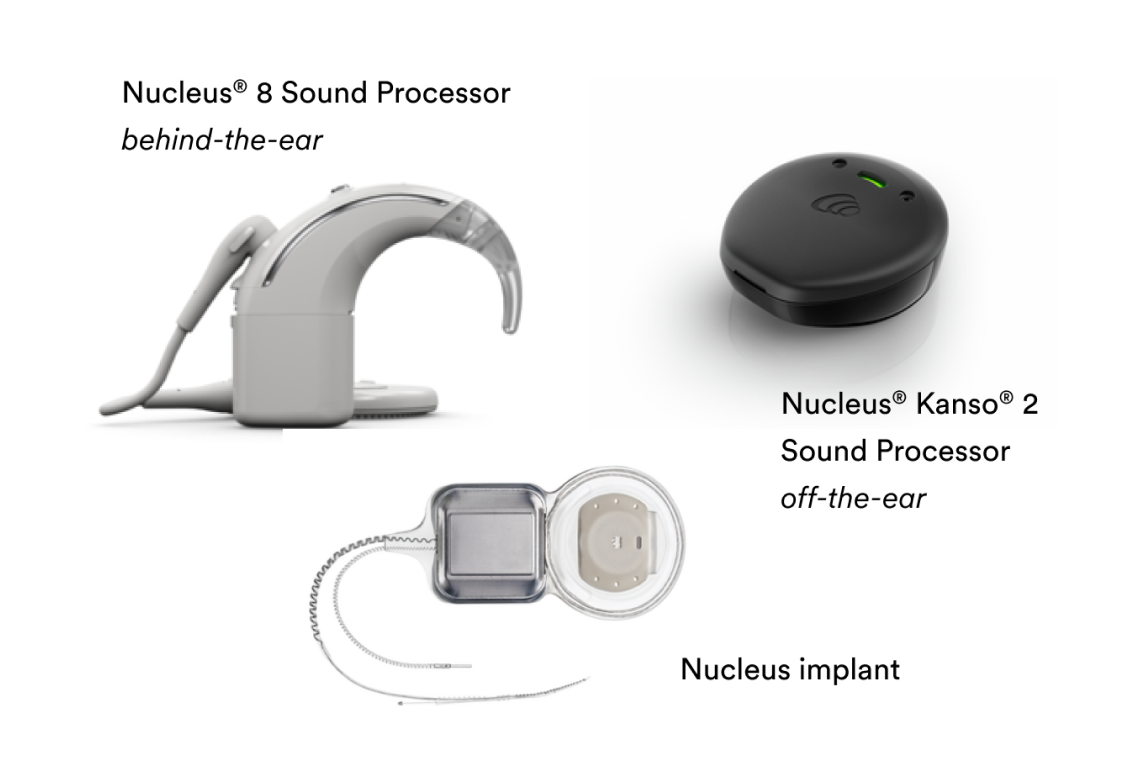
Do you qualify for a cochlear implant?
Do you qualify for a cochlear implant?
Cochlear implants work differently than hearing aids. Hearing aids help many people with hearing loss by making sounds louder. However, cochlear implants can be a more effective option for those with more significant hearing loss; specifically moderate to profound hearing loss in adults.
For some people, using a hearing aid(s) with a severe to profound hearing loss can be like listening to a loud, badly tuned radio. You may hear parts of what is being said and it may be loud enough, but the words are not clear.
Note: Wearing hearing aids first is a necessary step in the evaluation process for a cochlear implant.
Do you qualify for a cochlear implant?
Cochlear implants work differently than hearing aids. Hearing aids help many people with hearing loss by making sounds louder. However, cochlear implants can be a more effective option for those with more significant hearing loss; specifically moderate to profound hearing loss in adults.
For some people, using a hearing aid(s) with a severe to profound hearing loss can be like listening to a loud, badly tuned radio. You may hear parts of what is being said and it may be loud enough, but the words are not clear.
Note: Wearing hearing aids first is a necessary step in the evaluation process for a cochlear implant.
Cochlear implants can help you connect with the world around you
Cochlear implants can help you connect with the world around you
- Cochlear implants help improve speech understanding, sound clarity and language skills3 and hearing in noise4
- Cochlear implants help improve quality of life4 and employment opportunities5
Cochlear implants can help you connect with the world around you
- Cochlear implants help improve speech understanding, sound clarity and language skills3 and hearing in noise4
- Cochlear implants help improve quality of life4 and employment opportunities5
How the Cochlear™ Nucleus® Implant System works
How the Cochlear™ Nucleus® Implant System works
Cochlear implants mimic the function of a healthy inner ear, replacing damaged sensory hair cells to provide clearer sound than hearing aids. Since sensory hair cells don't regenerate, this hearing loss requires treatment. Our implants prioritize performance and preservation of cochlear structures. Surgeons can choose from a broad range of implants and electrodes based on hearing loss type, cochlea anatomy, and preference. The Cochlear™ Nucleus® System consists of two main components: the external sound processor and the surgically placed implant with an electrode array inserted in the cochlea.
How the Cochlear™ Nucleus® Implant System works
Cochlear implants mimic the function of a healthy inner ear, replacing damaged sensory hair cells to provide clearer sound than hearing aids. Since sensory hair cells don't regenerate, this hearing loss requires treatment. Our implants prioritize performance and preservation of cochlear structures. Surgeons can choose from a broad range of implants and electrodes based on hearing loss type, cochlea anatomy, and preference. The Cochlear™ Nucleus® System consists of two main components: the external sound processor and the surgically placed implant with an electrode array inserted in the cochlea.
Watch the video to see how it works
Watch the video to see how it works
Watch the video to see how it works
Mythbusters
Cochlear implant surgery is not brain surgery. The surgeon makes a small incision behind the ear, places the implant underneath the skin, delicately threads the electrodes into the cochlea and closes the incision site. In most cases, you can return home later the same day and can get back to your normal activities within a few days.
Cochlear implants have proven to be a successful solution for those who are in their 80s and even 90s. It's never too late to regain access to the sounds you're missing.
Many people believe you have to be completely deaf to get a cochlear implant. That is simply not true. In fact, you may be able to hear some sounds (like a baby crying or dog barking) even without hearing aids and still qualify for a cochlear implant. The moment you start struggling to hear and understand speech with your hearing aids in noise is the moment you should seek further evaluation by your local Hearing Implant Specialist.
A cochlear implant is designed to last a lifetime. You will be able to upgrade your sound processor as new technology becomes available while the internal components remain intact – typically no additional surgery required.
The process of getting a cochlear implant is step by step. First, start with being evaluated by a Hearing Implant Specialist to determine whether a cochlear implant may be a solution for you. From there, you will have the support you need to help you reach your hearing goals. The steps you take could make all the difference in how well you hear and participate in everyday life.
Disclaimer
For candidates residing in Canada, you should contact your local hearing implant center to determine coverage. The cost of a hearing implant may be covered by your provincial and territory health insurance plan. Every health insurance plan is different. Coverage varies by each province and territory, the type of hearing implant you may need and your hearing loss.
* Covered for Medicare beneficiaries who meet CMS criteria for coverage.
** Coverage for adult Medicaid recipients varies according to state-specific guidelines.
† Contact your insurance company or local Hearing Implant Specialist to determine your eligibility for coverage.
†† Coverage of hearing aids may be an option under some plans.
# The Cochlear Kanso 2 Sound Processor is compatible with Apple and Android devices, for compatibility information visit www.cochlear.com/compatibility.
Please seek advice from your health professional about treatments for hearing loss. Outcomes may vary, and your health professional will advise you about the factors which could affect your outcome. Always read the instructions for use. Not all products are available in all countries. Please contact your local Cochlear representative for product information.
References
1. Lupo JE, Biever A, Kelsall DC. Comprehensive hearing aid assessment in adults with bilateral severe-profound sensorineural hearing loss who present for Cochlear implant evaluation. Am J Otolaryngol. 2020;41(2):102300. doi:10.1016/j.amjoto.2019.102300
2. Balkany T, Hodges A, Menapace C, et al. Nucleus Freedom North American clinical trial. Otolaryngol Head Neck Surg 2007;136(5):757-762.
3. Novak MA, Firszt JB, Rotz LA, et al. Cochlear implants in infants and toddlers. Ann Otol Rhino Laryngol Suppl 2000;185:46-49.
4. Hirschfelder A, Gräbel S, Olze H. The impact of cochlear implantation on quality of life: The role of audiologic performance and variables. Otolaryngol Head Neck Surg. 2008 Mar;138(3): 357-362.
5. Wyatt JR, Niparko JK, Rothman M, deLissovoy G. Cost Utility of the Multichannel Cochlear Implant in 258 Profoundly Deaf Individuals. Laryngoscope.1996;106:816–821.
6. Cochlear Limited. D1190805 Processor Size Comparison. May 2022.
7. Mauger SJ, Warren C, Knight M, Goorevich M, Nel E. Clinical evaluation of the Nucleus 6 cochlear implant system: performance improvements with SmartSound iQ. International Journey Of Audiology. 2014, Aug; 53(8): 564-576. [Sponsored by Cochlear]
8. Mauger S, Jones M, Nel E, Del Dot J. Clinical outcomes with the Kanso™ off- the-ear cochlear implant sound processor. International Journal Of Audiology. 2017, Jan 9; 1-10. [Sponsored by Cochlear].
9. Wolfe J, Neumann S, Marsh M, Schafer E, Lianos L, Gilden J, O'Neill L, Arkis P, Menapace C, Nel E, Jones M. Benefits of Adaptive Signal Processing in a Commercially Available Cochlear Implant Sound Processor. Otol Neurotol. 2015 Aug;36(7):1181-90. [Sponsored by Cochlear]. [Sponsored by Cochlear].
10. Cochlear Limited D1864200 SCAN 2 Design Description
11. Cochlear Ltd. D1190805 Sound Processor Size Comparison. 2020; December. Data on file.
12. Cochlear Ltd. D1710313 CP1150 Battery Life Coverage Technical Report. 2020; Mar. Data on file.
13. Farinetti A, Roman S, Mancini J, et al. Quality of life in bimodal hearing users (unilateral cochlear implants and contralateral hearing aids). Eur Arch Otorhinolaryngol (2015 Nov); 272, 3209–3215.
14. Ching TY, Incerti P, Hill M. Binaural benefits for adults who use hearing aids and cochlear implants in opposite ears. Ear Hear (2004 Feb); 25, 9–21.
15. Potts LG, Skinner MW, Litovsky RA., et al. Recognition and localization of speech by adult cochlear implant recipients wearing a digital hearing aid in the nonimplanted ear (bimodal hearing). J Am Acad Audiol (2009 Jun); 20, 353–373.
16. Morera C, Cavalle L, Manrique M, et al. Contralateral hearing aid use in cochlear implanted patients: Multicenter study of bimodal benefit. Acta Otolaryngol (2012 Jun); 132, 1084–1094.
17. Sucher CM, McDermott HJ. Bimodal stimulation: benefits for music perception and sound quality. Cochlear Implants International. (2009 Jan); 1;10(S1):96-9.


